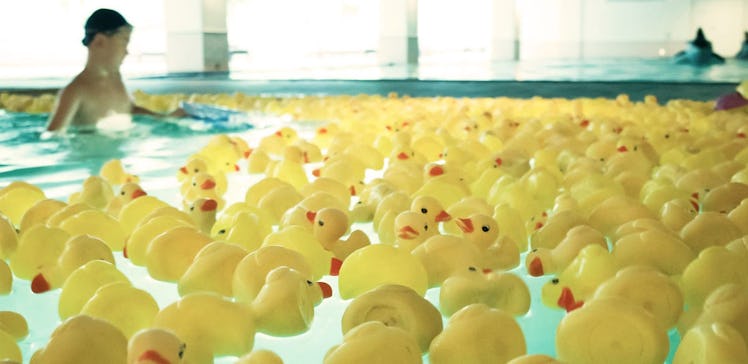Rubber Duck: The Wet And Wild History Of Your Kid’s Favorite Bath Toy
Rubber ducky, you're the one ...

Other than a tub — or maybe a loofah — there’s really no object on Earth that’s more synonymous with bathtime than a rubber duck. But how did this little, yellow, iconic kids bath toy make its way into America’s tub? It’s a journey that involves everyone from Charles Goodyear to Sesame Street’s Ernie. Here are some fast facts you can share with your kids. But hurry up, their fingers have started to prune.
RELATED: Baby Bath Toys for Toddlers Under $10
The Beginning
Rubber ducks have been around for about 65 million years. The modern rubber one is a little newer. Basically, it started with “vulcanized rubber”, the stuff that you drive on (and makes time travel possible). In 1844, Charles Goodyear mixed it with chemicals and polymers to make it more durable and patented the process. After that, commercial use of rubber skyrocketed.
The origins of the rubber duck are a little murky (like your kid’s bathwater), but it goes something like this: In the ’40s, the Rempel company of Akron, Ohio made the first iteration. It was a hollow, walking rubber duck with a sick mohawk. This duck was meant for land but, as indoor plumbing became more common in the ’50s, it found its way into suburban homes and bathtubs.
Contrary to popular belief, “rubber” ducks weren’t made of rubber for very long. Instead, as the bath toy became more popular, manufacturers opted for chemically-softened plastic (which they thought was less toxic — but actually turned out to be just as toxic). Later on, it changed to vinyl plastic (so far, so good on that one). But the name rubber ducky has endured.
But Why Ducks?
Back in the day, due to scarcer freshwater, and harder-to-catch children, bathing was a weekly event. So, in order to entice them to the tub, parents need a distraction.
Before the popularity boom, some rubber duckies were based on characters from Disney. In 1933, the Seiberling Latex Products Company licensed a series of Disney characters to make “bath floaters” (which has a different meaning today). The most popular of these characters were Donald and Donna (now Daisy) Duck.
Other companies took notice of the ducks’ dominance and, not wanting to deal with the hassles (and cost) of buying and maintaining a license, opted for a more generic duck design. According to the Toy Hall of Fame, sculptor Peter Ganine created the now-iconic form of the traditional rubber duck in the ’40s, patented it, and reproduced it as a primarily floating toy. He went on to sell more than 50 million of his creation, making the rubber duck one of the most popular toys of all time.
The Rubber Duck’s Big Moment
Chances are, your first experience with a rubber ducky took place on Sesame Street. By the early 1960s, the patent filed by Peter Ganine had been lifted (who can patent a duck, really?) Now free from restriction, these cheaply-made, low-cost friends were everywhere. On February 25, 1970, they showed up in a famous bathtub.
During the first season of Sesame Street, Ernie made the ducks famous by showing off his own — a prized and loyal friend, in his words — while playing in a tub amidst bubbles. It’s a catchy tune that you no doubt sing to your kid:
Rubber Duckie, you’re the one!
You make bathtime lots of fun!
Sound familiar? The song, written by Jeff Moss, and went on to sell more than 1 million copies, and reached number 11 on the Billboard chart. It was nominated for a Grammy, narrowly losing to The Sesame Street Book And Record, which featured the song, “Rubber Duckie.” So, it didn’t really “lose.” A few more quick notes:
- The song has been featured on 21 different albums
- There are recordings of it in Chinese, French, German, Hebrew, Spanish, and Dutch
- In 1996, a German version of the song sold 1.8 million copies
All because of a little duck.
The Rubber Duck’s Legacy
Now the duck has gone from a squeaky toy to a $99, Bluetooth-enabled rubber duck one. You can also buy rubber ducks that look like everyone from Elvis, to Donald Trump, to Jesus. Pop-culture has embraced the duck, inspiring everything from Warhol-esque paintings and prints to gigantic, floating sculptures. Ernie’s song has, of course, been mixed and remixed in just about every musical style (this version is particularly inspired/unnerving).
There’s just something about the bath toy that draws kids to the water like a duck to … also water. Whatever it is, it’s responsible for making bath time better. And for that, rubber duck is certainly the one.
This article was originally published on